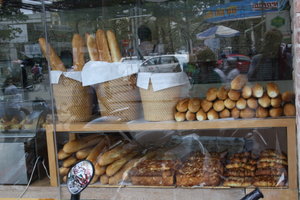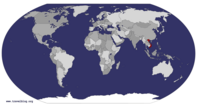Advertisement
Published: September 2nd 2010

 Breakfast Saigon style
Breakfast Saigon style
baguettes, pastries and strong coffee. Driven onto the streets by an indifferent hotel breakfast (a first in Vietnam), we explore the early morning eating options in Saigon. Having already joined the dawn tai-chi / ball room dancing / badminton set in the park across Pham Ngu Lao, hunger has driven us to some urgent research. We stumble across Tous Les Jours, a bakery and coffee chain, and indulge ourselves, matching French style patisserie goodies with ca phe sua da (Vietnamese coffee) - this will become a ritual for the remaining breakfasts of our stay in HCMC. Everything is freshly baked on the premises and the whole store smells hot and sweet. With comfortable easy chairs and a great view over the mad traffic, it is easy to while away quite a lot of the morning.
Food dominates much of the day.
We move on to explore Ben Thanh Indoor Market, the hub of District One; it is situated on one side of an enormous and busy roundabout to which every vehicle in Ho Chi Minh City seems to be drawn; added to this melee is the chaos of the main city bus depot on the other side, with passengers, luggage, buses all trying to
meet and leave on time. Next to Ban Thanh is Pho 1000, the pho restaurant visited by President Clinton, an event commemorated by several large photos inside; our visit for a late lunch yesterday when we arrived in Saigon seems to have slipped by with less impact.
The market itself is a huge square, colonnaded space, packed with clothes, suitcases, hats, shoes, jewelry, handbags and rows of coffee and tea. Piled high in the middle section are endless varieties (several of which we don't recognise) of fresh, vibrant fruit and veg: dark pink dragon fruit, yellow mangoes, enormous green and white striped watermelons, furry red-brown rambutans and so on - all glowing with freshness and stacked to create the greatest impact on the eye. At the far end, the meat and fish sections overlap with hot food stalls which are already doing a hectic lunch trade catering for the Vietnamese who had breakfasted a great deal earlier than we had. Trays packed with dishes are carried at shoulder height through the packed aisles to the stall-holders, who manage to eat and shout and sell all at the same time. The smells and colours reflect the fresh ingredients and the
herbs and spices ladled into every dish. Just outside, in an alleyway running under the eaves of the market which provide a covered walkway, the ice man nonchalantly moves his steaming blocks around, hacking chunks off into canvas bags or cardboard boxes to be hurried away to some stall or nearby shop. Every now and then, a large blue block shudders through a machine that instantly turns it into ice cubes, while spitting out steam and slivers of ice in a great hissing cloud. The ice man adds a stream of tobacco smoke to this cloud as he oversees this operation.
We emerge into a light rain and cross the roundabout, evading coaches from the bus station as well as the usual bikes and cars; a man on a bike festooned with bananas idles by, apparently impervious to the speeding vehicles weaving around him. In the middle, under a statue of a heroic warrior, a young couple in full wedding gear were having their photos taken against the backdrop of the market.
We are unable to find the outdoor market that is meant to be just round the corner, only a building site where it had once been,
with billboards promising some prestigious high rise, high end development; this seems typical of the way Saigon is evolving: there are building sites and scaffolding everywhere. In any case, we have already done enough markets for one morning and it was continuing to rain, so we head away from the centre of town towards the War Remnants' Museum. On the way, hungry again and bored of walking though puddles, we decide on an early lunch. Judging from the reactions when we walk into Pho Moi, westerners are unusual here, though almost immediately an American walks in and sits next to us. With immaculate courtesy, we are given tea and a menu, the latter proving somewhat challenging in places, with whole sections on lizards, doves, turtles, frogs. We go for some squid and morning glory with steamed rice, all of which is excellent, full of spices and garlic, and glasses of Vietnamese tea which are magically refilled as soon as they become empty. While downstairs is relatively quiet, there is clearly a large and increasingly riotous party going on the floor above. Trays of food and endless bottles of beer regularly disappear upstairs; laughter and songs waft back down.
The
War Remnants' Museum (originally known as the Museum of French and American War Crimes) absorbs us for the whole afternoon. We move from the hardware parked outside (archetypal Hueys, tanks, a jet fighter and other military equipment left behind by the Americans) to recreations of the tiger cages used during the French colonial period for imprisoning and torturing political prisoners. Inside, a mass of photos, newspaper cuttings and other exhibits illustrate the appalling nature of warfare in general and of the American War in particular. The section on the effects of Agent Orange is especially disturbing, not least as this is a consequence of war that is on-going today; indeed yesterday was National Agent Orange Day in Vietnam. The first "media" war has been documented in its full horror, and at great cost to the journalists and photographers who were there to record all that happened; a special section displays the work and biographies of all those correspondents who died during the war. This is a museum everyone should spend time in.
In sombre mood, therefore, we head towards the other side of Ho Chi Minh City to Chinatown, specifically to see the Chinese market. Our helpful driver only
gets round to mentioning that the market is about to close shortly before we arrive; he also demands a larger fare as I have given him "cheap" money (does he mean dong rather than dollars?) - we argue until I realise the debate is about 80p and I am standing in the rain... After the War Remnants Museum, it all seems rather trivial anyway.
Binh Tay market is quite different to Ben Thanh: it's bigger, less aesthetic and more businesslike, and bustling even though closing time is obviously near. It is built as a square, the four wings surrounding a garden and fountain in the centre; stalls are crammed in on two floors and also on the pavements outside and in the shop fronts opposite. It is scruffy and quite dirty. We buy a suitcase and get in the way of everyone shopping or closing up. It is almost dark when we emerge and still raining gently. Everywhere are puddles of black water and piles of rubbish, and the early evening is greasily steamy. We recover over a cold beer in a cafe across the street, watching the world go by on its scooter outside, while the proprietress eats
food delivered to her in tiffin boxes (rather than from her own counter); meanwhile a man on the street outside throws bricks and curses at the cars passing by, though no-one pays much notice.
The cafe has its own coffee and tea stall which does good business with many passers by, so we decide to snap up 300gms of ground Vietnamese coffee to keep us going when we get home. This involves much smelling of different coffee jars, eloquent gesticulation, no English, and a lot of laughter all round. A crows gathers to watch. What we eventually go away with is significantly cheaper than the "tourist price" for similar coffee on sale in Ben Thanh, so we feel a little smug, and a little better about our taxi fare.
Another taxi takes us back to District 1 and the Temple Club Restaurant: we are driven with great efficiency and concern to get us to the right place, as well as the usual questions: where are you from? do you like Vietnam? how long are you in Ho Chi Minh? We all agree Vietnam is number one. The Temple Club is as great a contrast to Cho Lon as
can be imagined. It is a smart, clean villa with lots of black wood panelling and well chosen pieces of furniture: this is colonial style living. We feel a little grubby and under-dressed after our adventures in Chinatown. The clientele is an odd mixture of business people and back-packers, but the food (spring rolls, salad and cheesecake) is good.
The day ends pretty much in reverse. We stroll home past Benh Thanh Market, which is still busy. The night market is crowded with shoppers and diners; traffic is still roaring around the roundabout. It has stopped raining now, but the puddles have brought the rats out, especially near the bus station. Passing along Pham Ngu Lao, the more elderly tai chi and badminton players of this morning have been replaced by a younger crown, mostly couples sitting close to each other on the kerb or on their scooters; others are playing badminton soccer, a kick about with a shuttlecock which is energetic and requires deft feet. Radios blare out Viet-pop music.
The back-packer bars are bright, loud and busy along PNL, but we stay outside, knowing we have an early start tomorrow as we head off to the Mekong Delta.
Advertisement
Tot: 0.074s; Tpl: 0.012s; cc: 10; qc: 48; dbt: 0.0367s; 1; m:domysql w:travelblog (10.17.0.13); sld: 1;
; mem: 1.2mb








